Matthew S. Williams's Blog, page 34
September 21, 2014
Developing World Tech: BRCK Mobile Internet Device
 Far from Silicon Valley in California, there is a place that some are now calling “Silicon Savannah.” Located around Nairobi, and centered on the nonprofit collective Ushahidi, an explosion in African tech is taking shape. And this month, backers of the collective’s 2013 Kickstarter campaign are finally getting their hands on BRCK – a long-awaited device that is the antithesis of shiny, expensive internet hardware.
Far from Silicon Valley in California, there is a place that some are now calling “Silicon Savannah.” Located around Nairobi, and centered on the nonprofit collective Ushahidi, an explosion in African tech is taking shape. And this month, backers of the collective’s 2013 Kickstarter campaign are finally getting their hands on BRCK – a long-awaited device that is the antithesis of shiny, expensive internet hardware.
A mobile Internet router, BRCK is essentially a self-powered, mobile Wi-Fi device that promises to bring internet access to remote communities and underdeveloped neighborhoods all around the world. And as an added bonus, it reverses the usual order of globalization – having been invented in a developing country, built in the US, and intended for customers in any country anywhere.
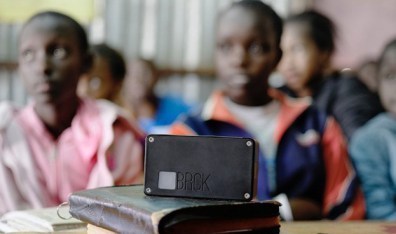 It can connect to the web in one of three ways: by plugging in a standard ethernet cable, by bridging with other Wi-Fi networks, or by accessing 3G or 4G data via a basic SIM card. Originally, Ushahidi invented it in order to overcome infrastructure challenges – specifically, inconsistent electricity and Internet connectivity – plaguing young upstarts in Nairobi. But it turns out, plenty of other people and places face the same challenges all over the world.
It can connect to the web in one of three ways: by plugging in a standard ethernet cable, by bridging with other Wi-Fi networks, or by accessing 3G or 4G data via a basic SIM card. Originally, Ushahidi invented it in order to overcome infrastructure challenges – specifically, inconsistent electricity and Internet connectivity – plaguing young upstarts in Nairobi. But it turns out, plenty of other people and places face the same challenges all over the world.
Contrary to public opinion, it is not just developing or underdeveloped countries that experience infrastructure challenges. Recently in the UK, Virgin Media customers across London lost service; while in the US, in what appeared to be an unrelated event, millions of Time Warner customers across the U.S. – largely in Chicago, Houston, Los Angeles, New York, and Tampa – were knocked offline.
 But even just focusing on the developing world, BRCK’s potential market is enormous. While only a quarter of people from the developing world are currently connected, they already account for a staggering two-thirds of all people online today. While the technology is not exactly cutting-edge by most standards, it offers numerous advantages that take the needs of its potential market into account.
But even just focusing on the developing world, BRCK’s potential market is enormous. While only a quarter of people from the developing world are currently connected, they already account for a staggering two-thirds of all people online today. While the technology is not exactly cutting-edge by most standards, it offers numerous advantages that take the needs of its potential market into account.
Beyond its three connection methods, BRCK can keep up to 20 users up and running for as long as eight hours during an electrical outage. And should the internet be unavailable in a given locale, the device continues operating offline, syncing up when its connection is restored. In addition, the stock hard drive is 4 gigabytes big, and it has a storage capacity of up to 32 gigabytes.
 BRCK CEO Erik Hersman, who cut his teeth in the industry as a blogger, sees the company’s base in Nairobi as one of its greatest assets, particularly given its target market. Having been born in Sudan and having settled in Kenya with his young family, ( is well-suited to addressing local needs with local solutions:
BRCK CEO Erik Hersman, who cut his teeth in the industry as a blogger, sees the company’s base in Nairobi as one of its greatest assets, particularly given its target market. Having been born in Sudan and having settled in Kenya with his young family, ( is well-suited to addressing local needs with local solutions:
I describe it as a new remix of old technology. That’s the key to understanding Africa’s technology… If it works in Africa, it’ll work anywhere… We’re playing with dirty power and crappy Internet, so the device has to be resilient.
While designed in Kenya, BRCK is manufactured and assembled in Texas by a company called Silicon Hills, which is located outside of Austin. With its matte black, rubberized case, BRCK is elegant, but mostly unassuming, and has the relative dimensions of an actual brick. It’s too large to fit in a pocket, but small enough to carry in a backpack, place on a desk, or even on the hood of your Land Rover in the African countryside.
 By weight, BRCK is substantially heavier than a plastic router, but it’s also much more than one. In addition to its battery, BRCK has multiple ports, including a general-purpose input/output, enabling users to program and connect other hardware – such as sensors or a solar charger – to the device. But what is perhaps most compelling about BRCK, are its potential applications.
By weight, BRCK is substantially heavier than a plastic router, but it’s also much more than one. In addition to its battery, BRCK has multiple ports, including a general-purpose input/output, enabling users to program and connect other hardware – such as sensors or a solar charger – to the device. But what is perhaps most compelling about BRCK, are its potential applications.
In truth, the greatest possibilities lies in the ability to break away from the model of centralized internet providers. This could lead to nothing short of a revolution in how people get online, and in way that would ensure a far greater measure of “equality of access”. As Hersman explained it:
We see enormous resonance with the work of other organizations. Take the proliferation of web-enabled laptops and tablets in schools; why is it that each of these devices connect to a mobile tower? Why not to a single, centralized point? …We’re at a place in history where the barriers to entry are no longer in the software space, but in the hardware space. Because we don’t yet have fully functioning maker spaces and rapid prototyping abilities here in Nairobi, the design process is still relatively slow and expensive, but the barriers are coming down.
 Education, health, environmental, and even military and governmental organizations are already in conversation with BRCK and multiple entities are testing it out. For consumers in emerging markets, BRCK’s $200 price tag may be a stretch, but the company is looking at purchasing plans, which have worked well in developing nations for both the cell phone and energy sectors.
Education, health, environmental, and even military and governmental organizations are already in conversation with BRCK and multiple entities are testing it out. For consumers in emerging markets, BRCK’s $200 price tag may be a stretch, but the company is looking at purchasing plans, which have worked well in developing nations for both the cell phone and energy sectors.
But BRCK’s business model is ultimately based more on companies than individual consumers. Digital Democracy, a nonprofit organization that has worked in two dozen countries around the world, is one such company. According to its founder and executive director, Emily Jacobi:
The reason that we backed BRCK and that I’m excited to see it come about is because it fills an important gap in hardware and tools. We’re going to remote areas and training groups – indigenous groups, refugees, and other at-risk populations – to map the land and communities using GPS devices and cameras. We’re particularly excited about BRCK’s ability to facilitate collaborative work, as well as function offline.
 If there was one thing that the Digital Revolution promised, it was to bring the world together. Naturally, there were those who thought this to be naive and idealistic, citing the fact that technology has a way of being unevenly distributed. And while today, people live in a world that is far more connected than in any previous age, access remains an illustrative example of the gap between rich and poor nations.
If there was one thing that the Digital Revolution promised, it was to bring the world together. Naturally, there were those who thought this to be naive and idealistic, citing the fact that technology has a way of being unevenly distributed. And while today, people live in a world that is far more connected than in any previous age, access remains an illustrative example of the gap between rich and poor nations.
Hence why an invention like the BRCK holds so much promise. Not only does it neatly reverse the all-too-common direction of technological development – i.e. technology conceived by a wealthy country, built in a poor one, only sold in wealthy ones – it also helps to shorten the gap between rich and poor nations when it comes to accessing and enjoying the fruits of that development.
This month, orders began shipping to buyers in 45 countries around the world this month. To get your hands on one, check out Ushahidi’s website and learn more about their efforts to develop open-source, equal-access technology.
Sources: fastcoexist.com, digital-democracy.org, ushahidi.com


News from Mars: MAVEN Orbiter Arrives!
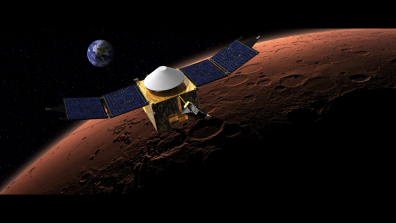 In November 2013, NASA launched the Mars Atmosphere and Volatile Evolution (MAVEN) space probe from Cape Canaveral. Described as a “time machine” for Mars, the orbiter would spend the next ten months traversing space, assuming an orbit around the Red Planet, and look for an answer as to how Mars went from being a planet with an atmosphere and water to the dried out husk that we know today.
In November 2013, NASA launched the Mars Atmosphere and Volatile Evolution (MAVEN) space probe from Cape Canaveral. Described as a “time machine” for Mars, the orbiter would spend the next ten months traversing space, assuming an orbit around the Red Planet, and look for an answer as to how Mars went from being a planet with an atmosphere and water to the dried out husk that we know today.
And this evening, after trekking some 711 million kilometers (442 million-mile) across our Solar System, MAVEN will have arrived in orbit around Mars and will begin its year-long mission to study the planet’s upper atmosphere. The arrival will be broadcast live, courtesy of NASA TV and Space.com. The live webcast will run from 9:30 p.m. to 10:45 p.m. EDT (0130 to 0245 GMT), and if all goes well, MAVEN will enter orbit around Mars at 9:50 p.m. EDT (0250 GMT).
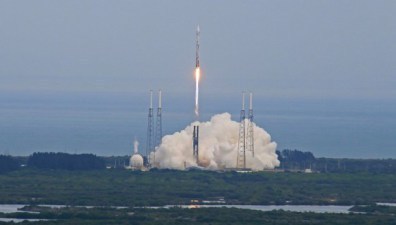 As David Mitchell, NASA’s MAVEN project manager at the Goddard Space Flight Center in Greenbelt, Maryland, said in a statement:
As David Mitchell, NASA’s MAVEN project manager at the Goddard Space Flight Center in Greenbelt, Maryland, said in a statement:
So far, so good with the performance of the spacecraft and payloads on the cruise to Mars. The team, the flight system, and all ground assets are ready for Mars orbit insertion.
Though plans to study Mars’ atmosphere in detail have been in the works for years, the MAVEN program received a big push from the ongoing efforts from the Curiosity rover. During its ongoing mission to study the surface of Mars, Curiosity was able to confirm that Mars had extensive surface water billions of years ago. This revelation came very early in the mission, and indicated some rather interesting things about Mars’ past.
 For instance, although Mars is now too cold for flowing water today, it might have had a thicker atmosphere in the past that warmed its surface and allowed the liquid to remain stable on the surface. And while scientists have a pretty good idea how it was lost (i.e. too far our Sun, too low a gravity field), the rate of loss and when it disappeared are just some of the questions that MAVEN will attempt to answer.
For instance, although Mars is now too cold for flowing water today, it might have had a thicker atmosphere in the past that warmed its surface and allowed the liquid to remain stable on the surface. And while scientists have a pretty good idea how it was lost (i.e. too far our Sun, too low a gravity field), the rate of loss and when it disappeared are just some of the questions that MAVEN will attempt to answer.
Much of what scientists know about Mars’ upper atmosphere comes from just a few minutes’ worth of data from the two Viking landers that took measurements as they made their way to the Martian surface in the 1970s. This time around, NASA will be able to collect data for an entire year, gathering far more data than either the Viking landers or any other spacecraft has since had the opportunity to do.
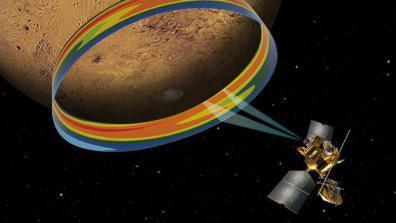 As Bruce Jakosky, the mission’s principal investigator at the University of Colorado, Boulder’s Laboratory for Atmospheric and Space Physics, explained it:
As Bruce Jakosky, the mission’s principal investigator at the University of Colorado, Boulder’s Laboratory for Atmospheric and Space Physics, explained it:
The MAVEN science mission focuses on answering questions about where did the water that was present on early Mars go, about where did the carbon dioxide go. These are important questions for understanding the history of Mars, its climate, and its potential to support at least microbial life.
NASA scientists understand that Mars’ upper atmosphere acts as an escape zone for molecules floating dozens of miles from the planet’s surface. They theorize that as the solar wind hits the atmosphere, the radiation strips away the lighter molecules and flings them into space forever. To test this hypothesis, MAVEN will be examining the state of Mars’ upper atmosphere, and ionosphere to determine its interactions with the solar wind.
 In so doing, NASA hopes to determine what the current rates of escape are for neutral gases and ions, and thus get a better picture of how long it took for the atmosphere to degrade and when it began degrading. The upper atmosphere of Mars likely changes as the sun’s activity increases and decreases, which is why MAVEN investigators hope to run the mission for longer than a year.
In so doing, NASA hopes to determine what the current rates of escape are for neutral gases and ions, and thus get a better picture of how long it took for the atmosphere to degrade and when it began degrading. The upper atmosphere of Mars likely changes as the sun’s activity increases and decreases, which is why MAVEN investigators hope to run the mission for longer than a year.
MAVEN will began making science measurements around Nov. 8, due to it taking a short break from its commissioning phase to watch Comet Siding Spring pass close by on Oct. 19. The $671 million MAVEN spacecraft is one of two missions that launched toward Mars last November and which are making their arrival this month. The other probe is India’s Mars Orbiter Mission, which launched just before MAVEN and will arrive at the Red Planet this Wednesday (Sept. 24).
It is an exciting time for space exploration, and the coming years are sure to be characterized by an escalating and accelerating rate of learning. Be sure to head on over to Space.com to watch the arrival broadcast live. And be sure to check out the following videos – the Mars Arrival trailer; NASA Goddard Center’s “Targeting Mars” video; and the NASA MAVEN PSA, hosted by LeVar Burton:
MAVEN Mars Arrival Trailer:
Targeting Mars:
LeVar Burton Shares MAVEN’s Story:
Sources: space.com, (2), nasa.gov


September 20, 2014
News from Mars: Soil Good for Growing!
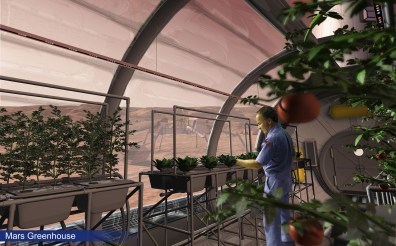 With numerous plans for a manned mission to Mars, some of which are scheduled to one-way settlement projects, the question of how and what people on Mars will eat is an important one. What will the Martian diet look like? How will they grow their food? Will it people subsist on endless supplies of freeze-dried rations, or will they get all the veggies, fruits and protein they need from hydroponic produce?
With numerous plans for a manned mission to Mars, some of which are scheduled to one-way settlement projects, the question of how and what people on Mars will eat is an important one. What will the Martian diet look like? How will they grow their food? Will it people subsist on endless supplies of freeze-dried rations, or will they get all the veggies, fruits and protein they need from hydroponic produce?
Well, according to Dutch ecologist Wieger Wamelink, the Martian settlers might just be able to grow their food in the local soil. In a series of experiments using soil tailored to fit extra-terrestrial environments, Wamelink was able to make a mustard seed sprout. The soil was provided by NASA, a sample which they had collected from the desert, dried out, and cleansed of certain nutrients that’s meant to replicate what Martian and lunar soil would be like.
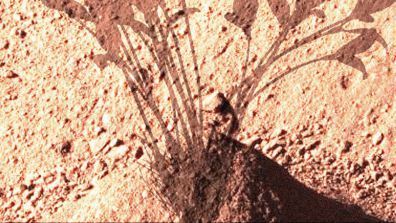 Wamelink had ordered more than 100 pounds of each type to his research greenhouse in the Netherlands to see what kinds of plant life might prosper in greenhouses on other planets. He and his team planted tomato seeds, stinging nettle, carrots, rye, and a host of other wild species in the soils in a series of 840 pots, then published their results in PLOS One late last month.
Wamelink had ordered more than 100 pounds of each type to his research greenhouse in the Netherlands to see what kinds of plant life might prosper in greenhouses on other planets. He and his team planted tomato seeds, stinging nettle, carrots, rye, and a host of other wild species in the soils in a series of 840 pots, then published their results in PLOS One late last month.
As Wamelink, who works for the Alterra Institute at the University of Wageningen, explained:
I think we’re really the first to do that. We have looked at how plants see what [nutrients are] available in these soils, and it was unknown to NASA. They were very happy when we sent our results.
 What was perhaps most impressive about the results was how well some plants fared in the imitation Mars soil. Some seeds germinated after just 24 hours and flowered within 50 days, something Wamelink had never expected. He knew that nitrogen might not be available in alien soils, but when he analyzed the Martian soil compared to nutrient-poor sand from the banks of the Rhine, he found that Mars actually had much more going for it than he thought.
What was perhaps most impressive about the results was how well some plants fared in the imitation Mars soil. Some seeds germinated after just 24 hours and flowered within 50 days, something Wamelink had never expected. He knew that nitrogen might not be available in alien soils, but when he analyzed the Martian soil compared to nutrient-poor sand from the banks of the Rhine, he found that Mars actually had much more going for it than he thought.
The Martian atmosphere contains nitrogen, and gusts of gases from the sun charge the nitrogen into a form that is digestible for plants. The planet also contains phosphorus, ammonium, and nitrates – all essential for plant growth. Field mustard and a tough, wild Dutch species called “reflexed stone crop” produced some of the best results. Lunar soil, by contrast, didn’t provide very friendly turf for earthling plant species.
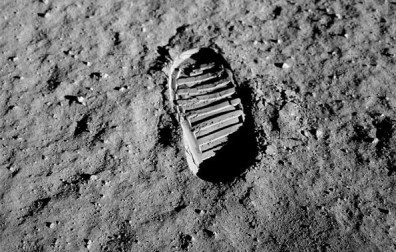 Soil on the moon is thin, dusty, and full of aluminum and other heavy metals. Martian soil also contains lots of heavy metals, but it is aluminum that most plants don’t do too well in the presence of. So for the time being (or rather, if and when we settle the Moon), Lunar greenhouses will have to look to imports of Earth soil while Martian settlers can simple scoop the soil they need from outside their airlocks.
Soil on the moon is thin, dusty, and full of aluminum and other heavy metals. Martian soil also contains lots of heavy metals, but it is aluminum that most plants don’t do too well in the presence of. So for the time being (or rather, if and when we settle the Moon), Lunar greenhouses will have to look to imports of Earth soil while Martian settlers can simple scoop the soil they need from outside their airlocks.
However, there are a few snags. For starters, even though Wamelink’s study provided some of the first evidence that species of Earth plants can grow on planets other than Earth, it still doesn’t show how eating those plants might affect humans. The Martian surface experiences lots of radiation, and eating radioactive plants full of heavy metals might not be the best idea for the human digestive system.
 Nevertheless, Wamelink believes that some aspects of the Martian climate might actually be beneficial for plant growth. On a planet with a third of the gravitational pull of Earth, he suspects that plants might be able to grow taller than they ever would on their home planet. In his mind’s eye, he pictures plants encased in skyscraper Martian greenhouses. Alas, not all scientists agree with him, and he admits its an unresolved issue.
Nevertheless, Wamelink believes that some aspects of the Martian climate might actually be beneficial for plant growth. On a planet with a third of the gravitational pull of Earth, he suspects that plants might be able to grow taller than they ever would on their home planet. In his mind’s eye, he pictures plants encased in skyscraper Martian greenhouses. Alas, not all scientists agree with him, and he admits its an unresolved issue.
Still, its an exciting one that is loaded with potential. And who’s to say that after a little processing and decontamination, Martian soil would have everything the settlers need to grow their own food? The very fact that it is being considered and examined so seriously shows our commitment to making an enduring human presence on Mars a reality someday. And as that day get’s closer, more and more questions are likely to be addressed.
 And figuring out how to grow our own crops in Martian soil will provide inevitable feedback on how we could use Earth plants to one day convert the ecology of the Red Planet and make it into something a little more suited to full-scale habitation. Who knows? In a few centuries time, Red Mars may become Green Mars. And perhaps even Blue Mars. Oh, Kim Stanley Robinson, you daring dreamer, you!
And figuring out how to grow our own crops in Martian soil will provide inevitable feedback on how we could use Earth plants to one day convert the ecology of the Red Planet and make it into something a little more suited to full-scale habitation. Who knows? In a few centuries time, Red Mars may become Green Mars. And perhaps even Blue Mars. Oh, Kim Stanley Robinson, you daring dreamer, you!
Source: fastcoexist.com


September 19, 2014
Judement Day Update: IBM Watson’s Hard Questions
 When IBM’s artificial intelligence program – named Watson – won Jeopardy in 2011, it was a major boon for the industry. However, far from showing that it was Turing-compatible, Watson was merely processing information that it had been programmed to know. But now, IBM is pushing the software forward in the hopes that the machine will be able to answer the really tough questions – i.e. the ones that have no answer and require educated guesses.
When IBM’s artificial intelligence program – named Watson – won Jeopardy in 2011, it was a major boon for the industry. However, far from showing that it was Turing-compatible, Watson was merely processing information that it had been programmed to know. But now, IBM is pushing the software forward in the hopes that the machine will be able to answer the really tough questions – i.e. the ones that have no answer and require educated guesses.
This is part of IBMs attempts to turn Watson into a new line of business and make it useful in a wide range of industries that are dealing lately with an overwhelming amount of data. At an event in New York at the end of August, IBM showed off the ways some of its early customers are using the Watson “Discovery Advisor” in research, development, and innovation, especially in the realm of biotech and life sciences.
 Watson’s aim is to speed up discoveries by teams of researchers by, for example, scanning and interpreting millions of scientific books, articles, and data points–far more than any person’s brain could analyze–and generating new hypothesis or leads that might be fruitful to investigate. As John Gordon, the vice-president of IBM’s Watson group, put it, it’s all about giving researchers “smarter hunches”:
Watson’s aim is to speed up discoveries by teams of researchers by, for example, scanning and interpreting millions of scientific books, articles, and data points–far more than any person’s brain could analyze–and generating new hypothesis or leads that might be fruitful to investigate. As John Gordon, the vice-president of IBM’s Watson group, put it, it’s all about giving researchers “smarter hunches”:
It’s not giving answers that people know anymore, it’s pointing people in directions that they should investigate. We’re talking about a computing system that inspires people.
Scientists at the Baylor College of Medicine and IBM Research have already used Watson to discover new pathways to cancer therapies, which they reported in a study presented at an academic conference late last month. Watson looked closely at 70,000 scientific articles on a protein, called p53, that’s involved in more than half of all cancers, and picked out 6 different proteins that it felt were good candidates for new drugs and therapies.
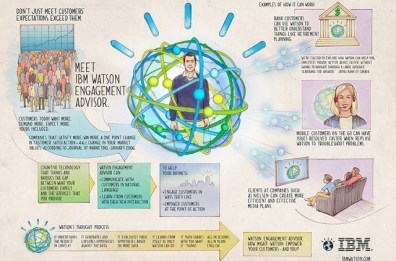 Drug companies, too, which are struggling today to develop new commercial drugs, are some of the earliest users of Watsons predictive capabilities. Sanofi is using Watson to look through the research literature and its own data to find new uses for its existing drugs on the market. And Johnson & Johnson has developed a system that analyzes clinical studies to compare the efficacy and safety of different treatments.
Drug companies, too, which are struggling today to develop new commercial drugs, are some of the earliest users of Watsons predictive capabilities. Sanofi is using Watson to look through the research literature and its own data to find new uses for its existing drugs on the market. And Johnson & Johnson has developed a system that analyzes clinical studies to compare the efficacy and safety of different treatments.
Soledad Cepeda, Johnson & Johnson’s director of epidemiology, used the example of back pain, for which there are 27 treatments studied in more than 3,000 clinical trials. As she explained:
[Analyzing this] is slow, it’s tedious, it’s expensive, and it’s prone to errors. Now imagine we can teach Watson to do that for us. So instead of six months, Watson can do it in minutes.
 Johnson & Johnson has been working to train Watson to read each study, put it in context, and pick out how many patients dropped out of the study or trial due to side effects or ineffective results. If Watson can give researchers all of this comparative data, rather than them combing through thousands of papers, it would allow researchers to come up with better questions to ask and directions to explore.
Johnson & Johnson has been working to train Watson to read each study, put it in context, and pick out how many patients dropped out of the study or trial due to side effects or ineffective results. If Watson can give researchers all of this comparative data, rather than them combing through thousands of papers, it would allow researchers to come up with better questions to ask and directions to explore.
But of course, this is not always an easy things for Watson to do and requires setup and new skills for it to learn. For example, in Johnson & Johnson’s work, in the studies Watson was analyzing, authors often reported the key data in the form of flow diagrams. So Soledad and her team had to first teach Watson to correctly read flow diagrams of varying levels of complexity and design.
 So far, Watson’s earliest discovery applications have been in the field of biomedical research. But the company hopes it will prove useful in a wide array of fields where the data available to analyze is growing faster than even the world’s top experts are capable of comprehending – such as law enforcement and finance. Whether it’s determining whodunnit, or predicting market trends in the next quarter, Watson could prove very helpful in tackling the task of big-data crunching.
So far, Watson’s earliest discovery applications have been in the field of biomedical research. But the company hopes it will prove useful in a wide array of fields where the data available to analyze is growing faster than even the world’s top experts are capable of comprehending – such as law enforcement and finance. Whether it’s determining whodunnit, or predicting market trends in the next quarter, Watson could prove very helpful in tackling the task of big-data crunching.
To illustrate the potential for law enforcement, Roberto Villasenor, chief of police for the city of Tucson, Arizona, spoke at the event and detailed an open case of a young child who went missing from her home. Over two years of investigating, the police have generated 15,000 pages of lab reports, records, and warrants, 25,00 pages of interviews, 4,000 pages of transcribed wiretaps, and much other data.
 His department has already worked with IBM on software that integrates different police databases to make it easier for investigators to make connections between disparate data sources. But he hopes systems like Watson will eventually go further and be capable of aiding investigators in combing through data, making subtle connections, and generating new leads in difficult cases.
His department has already worked with IBM on software that integrates different police databases to make it easier for investigators to make connections between disparate data sources. But he hopes systems like Watson will eventually go further and be capable of aiding investigators in combing through data, making subtle connections, and generating new leads in difficult cases.
However, the most public demonstration of Watson’s new abilities thus far has been in the form of “Chef Watson”. IBM has put Watson to the task of learning how to cook and then creating creative tasty and unexpected new recipes. It debuted this capability at a food truck at SxSW this year, but has also been working with the Institute of Culinary Education and Bon Appetit magazine to refine and stretch Watson’s cooking skills.
 Bon Appetit is now beta testing a consumer app that allows readers to input an ingredient and desires and have Watson generate suggested recipes. It held a Watson recipe contest this summer–the winner of the “best use of Watson as a creative discovery tool” was a “Roasted tomato and mozzarella tart” recipe. Cooking isn’t like curing cancer or solving crimes, but to IBM it’s most about getting the public excited about its advances.
Bon Appetit is now beta testing a consumer app that allows readers to input an ingredient and desires and have Watson generate suggested recipes. It held a Watson recipe contest this summer–the winner of the “best use of Watson as a creative discovery tool” was a “Roasted tomato and mozzarella tart” recipe. Cooking isn’t like curing cancer or solving crimes, but to IBM it’s most about getting the public excited about its advances.
As IBM senior vice president Mike Rhodin said:
Much the same way that Jeopardy helped people understand systems that can answer questions using natural language, Chef Watson is a way for us to understand how these new systems can be used in our everyday lives.
And that’s the real aim here, long-term, which is adapting computer-learning into our daily lives. And given time, we may have access to AIs that can do the difficult and mind-numbing task of sifting through gigabytes, terabytes and even petabytes of information in order to find answers to tough questions, discern the patterns, and come up with solutions. One can only hope they don’t use that information for evil and try to destroy us!
Knowledge is power, after all…
Sources: fastcoexist.com, bcm.edu


The Future of Flight: Hybrid-Electric VTOL Aircraft
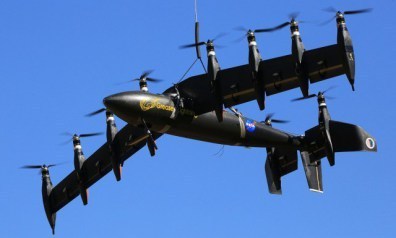 It may look like something a dedicated hobbyist built, and sound like something cheekily named, but NASA’s new electrical vertical take-off and landing (VTOL) machine is a very serious venture. Known as the GL-10 Greased Lightning, this unmanned hybrid-electric aircraft is the agency’s proposal for a vehicle that one day replace the reigning champion of VTOL – the helicopter.
It may look like something a dedicated hobbyist built, and sound like something cheekily named, but NASA’s new electrical vertical take-off and landing (VTOL) machine is a very serious venture. Known as the GL-10 Greased Lightning, this unmanned hybrid-electric aircraft is the agency’s proposal for a vehicle that one day replace the reigning champion of VTOL – the helicopter.
The G-10 is in part the result of the recent strides made in electric propulsion, which is made possible thanks to the growing power and energy density of batteries allows for some very efficient hybrid-electric aircraft designs. With eight prop engines mounted on the two main wings and another two mounted on the tail, the vehicle swivels them into vertical position for takeoff and landing, and then horizontal for conventional flight.
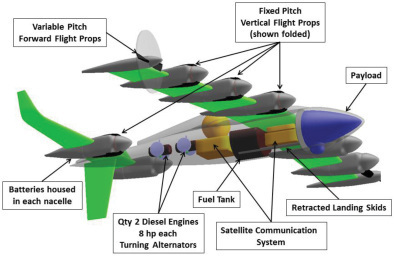 While it’s not particularly hard to create an aircraft capable of VTOL, it has so far proven to be very tough to create an aircraft that can also efficiently cruise through the air after taking off vertically. The helicopter is the only common example of a VTOL aircraft that can also cruise acceptably, but at a cost. Compared to other aircraft, an everyday helicopter has a much lower-lift-drag ratio, which means it burns more fuel, has less range and can carry less weight.
While it’s not particularly hard to create an aircraft capable of VTOL, it has so far proven to be very tough to create an aircraft that can also efficiently cruise through the air after taking off vertically. The helicopter is the only common example of a VTOL aircraft that can also cruise acceptably, but at a cost. Compared to other aircraft, an everyday helicopter has a much lower-lift-drag ratio, which means it burns more fuel, has less range and can carry less weight.
However, electric propulsion allows for much more efficient designs, since vehicles no longer have to accommodate large fossil fuel-powered engines or manage the mechanical stress across the airframe. Instead, they can rely on smaller, more efficient, optimally placed electric motors, and without the mechanical complexity of big jet engines, it suddenly becomes a lot easier to have wings and propellers that can swivel between horizontal and vertical.
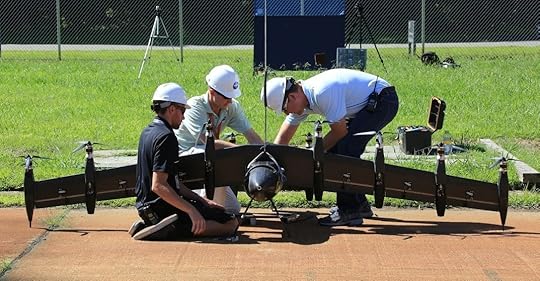 While pure-electric aircraft do exist – in the form of quadcopters – hybrid-electric designs with longer range are generally of more interest to military and commercial groups. In the case of NASA’s Greased Lightning, there are two small diesel engines in the body of the aircraft that turn electric alternators that constantly recharge the lithium batteries. This theoretically gives the GL-10 the same range and duration as a modern plane alongside its VTOL capability.
While pure-electric aircraft do exist – in the form of quadcopters – hybrid-electric designs with longer range are generally of more interest to military and commercial groups. In the case of NASA’s Greased Lightning, there are two small diesel engines in the body of the aircraft that turn electric alternators that constantly recharge the lithium batteries. This theoretically gives the GL-10 the same range and duration as a modern plane alongside its VTOL capability.
Interestingly, NASA also says that such a hybrid-electric design is “scale free” — meaning the same principles could be used to revolutionize everything from helicopters, to military UAVs, to massive jetliners. Much like hybrid-electric cars, the concept is set to revolutionize an entire fleet of aircraft designs that could be far more efficient than they currently are. One party who is sure to be interested in the possibilities is the US military, with its ever growing fleet of UAVs.
For now, Greased Lightning only has a wingspan of 3 meters (10 feet), and on its first test flight – which took place on National Aviation Day, August 19 – it was tethered. Untethered flights are planned for later in the year, an event which is sure to be a media sensation and produce some viral videos!
Source: extremetech.com


September 18, 2014
News from Space: Orion Spacecraft Completed
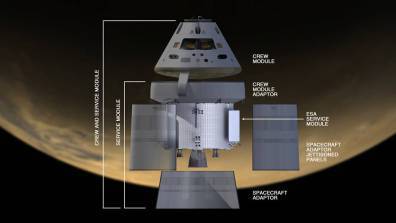 NASA’s return to manned spaceflight took a few steps forward this month with the completion of the Orion crew capsule. As the module that will hopefully bring astronauts back to the Moon and to Mars, the capsule rolled out of its assembly facility at the Kennedy Space Center (KSC) on Thursday, Sept. 11. This was the first step on its nearly two month journey to the launch pad and planned blastoff this coming December.
NASA’s return to manned spaceflight took a few steps forward this month with the completion of the Orion crew capsule. As the module that will hopefully bring astronauts back to the Moon and to Mars, the capsule rolled out of its assembly facility at the Kennedy Space Center (KSC) on Thursday, Sept. 11. This was the first step on its nearly two month journey to the launch pad and planned blastoff this coming December.
Orion’s assembly was just completed this past weekend by technicians and engineers from prime contractor Lockheed Martin inside the agency’s Neil Armstrong Operations and Checkout (O & C) Facility. And with the installation of the world’s largest heat shield and the inert service module, all that remains is fueling and the attachment of its launch abort system before it will installed atop a Delta IV Heavy rocket.
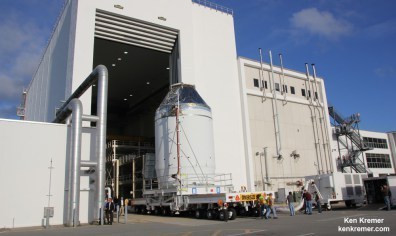 The unmanned test flight – Exploration Flight Test-1 (EFT-1) – is slated to blast off on December 2014, and will send the capsule into space for the first time. This will be NASA’s first chance to observe how well the Orion capsule works in space before it’s sent on its first mission on the Space Launch System (SLS), which is currently under development by NASA and is scheduled to fly no later than 2018.
The unmanned test flight – Exploration Flight Test-1 (EFT-1) – is slated to blast off on December 2014, and will send the capsule into space for the first time. This will be NASA’s first chance to observe how well the Orion capsule works in space before it’s sent on its first mission on the Space Launch System (SLS), which is currently under development by NASA and is scheduled to fly no later than 2018.
The Orion is NASA’s first manned spacecraft project to reach test-flight status since the Space Shuttle first flew in the 1980s. It is designed to carry up to six astronauts on deep space missions to Mars and asteroids, either on its own or using a habitat module for missions longer than 21 days. The development process has been a long time in the making, and had more than its share of bumps along the way.
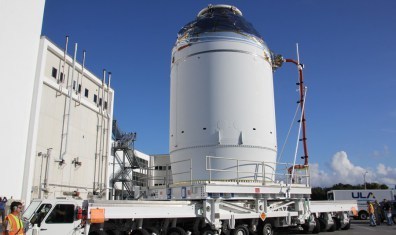 As Mark Geyer, Orion Program manager, explained:
As Mark Geyer, Orion Program manager, explained:
Nothing about building the first of a brand new space transportation system is easy. But the crew module is undoubtedly the most complex component that will fly in December. The pressure vessel, the heat shield, parachute system, avionics — piecing all of that together into a working spacecraft is an accomplishment. Seeing it fly in three months is going to be amazing.
In addition to going to the Moon and Mars, the Orion spacecraft will carry astronauts on voyages venturing father into deep space than ever before. This will include going to the Asteroid Belt, to Europa (to see if there’s any signs of life there), and even beyond – most likely to Enceladus, Titan, the larger moons of Uranus, and all the other wondrous places in the Solar System.
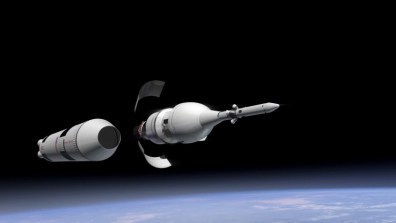 The two-orbit, four and a half hour EFT-1 flight will lift the Orion spacecraft and its attached second stage to an orbital altitude of 5,800 km (3,600 miles), about 15 times higher than the International Space Station (ISS) – and farther than any human spacecraft has journeyed in 40 years. It will be an historic occasion, and constitute an important step in what is sure to be known as the Second Space Age.
The two-orbit, four and a half hour EFT-1 flight will lift the Orion spacecraft and its attached second stage to an orbital altitude of 5,800 km (3,600 miles), about 15 times higher than the International Space Station (ISS) – and farther than any human spacecraft has journeyed in 40 years. It will be an historic occasion, and constitute an important step in what is sure to be known as the Second Space Age.
And be sure to watch this time-lapse video of the Orion Capsule as it is released from the Kennedy Space Center to the Payload Hazardous Servicing Facility in preparation for its first flight:
Sources:
gizmag.com, universetoday.com


September 17, 2014
News from Space: Rosetta Maps Comet Surface
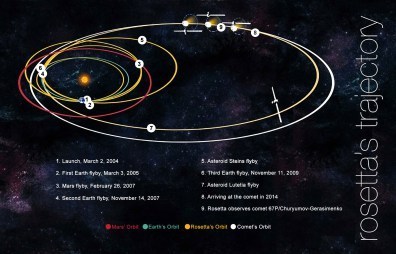 Last month, the European Space Agency Rosetta’s space probe arrived at the comet known as 67P/Churyumov–Gerasimenko, thus becoming the first spacecraft to ever rendezvous with a comet. As it continues on its way to the Inner Solar System, Rosetta’s sensing instruments have been studying the surface in detail in advance of the attempted landing of it’s Philae probe.
Last month, the European Space Agency Rosetta’s space probe arrived at the comet known as 67P/Churyumov–Gerasimenko, thus becoming the first spacecraft to ever rendezvous with a comet. As it continues on its way to the Inner Solar System, Rosetta’s sensing instruments have been studying the surface in detail in advance of the attempted landing of it’s Philae probe.
Because of this, Rosetta has been able to render a map of the various areas on the surface of the comet, showing that it is composed of several different regions created by a range of forces acting upon the object. Images of the comet’s surface were captured by OSIRIS, the scientific imaging system aboard the Rosetta spacecraft, and scientists analyzing them have divided the comet into several distinct regions, each characterized by different classes of features.
 All told, areas containing cliffs, trenches, impact craters, rocks, boulders and parallel grooves have been identified and mapped by the probe. Some of the areas that have been mapped appear to be caused by aspects of the activity occurring in and around the nucleus of the comet, such as where particles from below the surface are carried up by escaping gas and vapor and strewn around the surface in the surrounding area.
All told, areas containing cliffs, trenches, impact craters, rocks, boulders and parallel grooves have been identified and mapped by the probe. Some of the areas that have been mapped appear to be caused by aspects of the activity occurring in and around the nucleus of the comet, such as where particles from below the surface are carried up by escaping gas and vapor and strewn around the surface in the surrounding area.
So detailed are these images that many have been captured at a resolution of one pixel being equal to an area of 194 square centimeters (30 square inches) on the comet surface. Dr. Holger Sierks, OSIRIS’ Principal Investigator from the Max Planck Institute for Solar System Science, puts it into perspective:
Never before have we seen a cometary surface in such detail. It is a historic moment – we have an unprecedented resolution to map a comet… This first map is, of course, only the beginning of our work. At this point, nobody truly understands how the surface variations we are currently witnessing came to be.
 The newly-generated comet maps and images captured by the instruments on Rosetta will now provide a range of detail on which to finalize possible landing sites for the Philae probe to be launched to the surface . As such, the Rosetta team will meet in Toulouse, France, on September 13 and 14 to allocate primary and backup landing sites (from a list of sites previously selected) with much greater confidence.
The newly-generated comet maps and images captured by the instruments on Rosetta will now provide a range of detail on which to finalize possible landing sites for the Philae probe to be launched to the surface . As such, the Rosetta team will meet in Toulouse, France, on September 13 and 14 to allocate primary and backup landing sites (from a list of sites previously selected) with much greater confidence.
At the same time, Rosetta has revealed quite a bit about the outward appearance of the comet, and it aint pretty! More often than not, comets are described as “dirty snowballs” to describe their peculiar composition of ice and dust. But Rosetta’s Alice instrument, which was installed by NASA, has sent back preliminary scientific data that shows that the comet is more akin to a lump of coal.
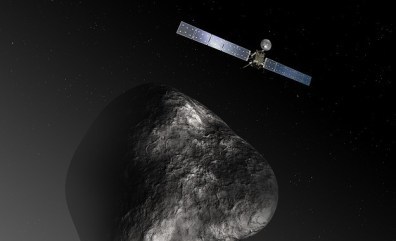 Alice is one of eleven instruments carried aboard Rosetta and one of three instrument packages supplied by NASA for the unmanned orbiter. Essentially, it’s a miniature UV imaging spectrograph that looks for thermal markers in the far ultraviolet part of the spectrum in order to learn more about the comet’s composition and history. It does this by looking specifically for the markers associated with noble gases, such as helium, neon, argon, and krypton.
Alice is one of eleven instruments carried aboard Rosetta and one of three instrument packages supplied by NASA for the unmanned orbiter. Essentially, it’s a miniature UV imaging spectrograph that looks for thermal markers in the far ultraviolet part of the spectrum in order to learn more about the comet’s composition and history. It does this by looking specifically for the markers associated with noble gases, such as helium, neon, argon, and krypton.
The upshot of all this high-tech imaging is the surprising discovery of what 67P/Churyumov-Gerasimenko looks like. According to NASA, the comet is darker than charcoal. And though Alice has detected oxygen and hydrogen in the comet’s coma, the patches of barren ice that NASA scientists had expected aren’t there. Apparently, this is because 67P/Churyumov-Gerasimenko is too far away from the warmth of the sun to turn the ice into water vapor.
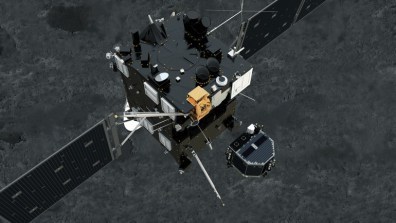 Alan Stern, Alice principal investigator at the Southwest Research Institute in Boulder, Colorado, had this to say about the revelation:
Alan Stern, Alice principal investigator at the Southwest Research Institute in Boulder, Colorado, had this to say about the revelation:
We’re a bit surprised at just how unreflective the comet’s surface is and how little evidence of exposed water-ice it shows.
Launched in 2004, Rosetta reached 67P/Churyumov-Gerasimenko by a circuitous route involving three flybys of Earth, one of Mars, and a long detour out beyond Jupiter as it built up enough speed to catch up to the comet. Over the coming months, as the Rosetta spacecraft and comet 67P move further into the solar system and approach the sun, the OSIRIS team and other instruments on the payload will continue to observe the comet’s surface for any changes.
 Hence why this mission is of such historic importance. Not only does it involve a spacecraft getting closer to a comet than at time in our history, it also presents a chance to examine what happens to a comet as it approaches our sun. And if indeed it does begin to melt and breakdown, we will get a chance to peer inside, which will be nothing less than a chance to look back in time, to a point when our Solar System was still forming.
Hence why this mission is of such historic importance. Not only does it involve a spacecraft getting closer to a comet than at time in our history, it also presents a chance to examine what happens to a comet as it approaches our sun. And if indeed it does begin to melt and breakdown, we will get a chance to peer inside, which will be nothing less than a chance to look back in time, to a point when our Solar System was still forming.
Sources: gizmag, (2), jpl.nasa.gov, nasa.gov


September 16, 2014
The Future of Tanks: Ground X and Scout Specialist Vehicles
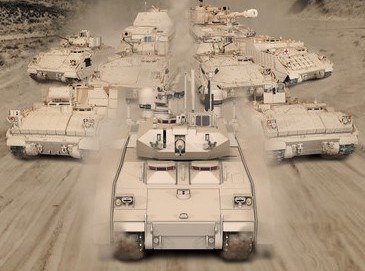 As armies continue to modernize, the challenge of creating new fighting vehicles that withstand the latest in battlefield conditions, and at the same time be more cost-effective, is a constant. And, as the latest announcements made by DARPA and General Dynamics over the course of the summer can attest, its been known to produce some pretty interesting and innovate design concepts.
As armies continue to modernize, the challenge of creating new fighting vehicles that withstand the latest in battlefield conditions, and at the same time be more cost-effective, is a constant. And, as the latest announcements made by DARPA and General Dynamics over the course of the summer can attest, its been known to produce some pretty interesting and innovate design concepts.
Known as the Ground X-Vehicle Technology (or GXV-T for short) the aim of this DARPA-funded program is to develop a lighter, more agile successors to the tank. Whereas tanks in the past have always responded to the development of more and better anti-tank weapons with heavier more elaborate armor, the focus of the GXV-T will be on protection that does not result in yet another bigger, badder, and way more expensive tank.
 Beginning in 1917, the development of the tank led to a revolution is modern warfare, which has led to an ongoing arms race ever since. In just the last half-century, the guns used to take out tanks have been joined by rockets, guided missiles, and high-tech rounds designed to penetrate the thickest steel. Tank designers have responded with composite armor, reactive armor, and even electric countermeasures to detonate warheads before they make contact.
Beginning in 1917, the development of the tank led to a revolution is modern warfare, which has led to an ongoing arms race ever since. In just the last half-century, the guns used to take out tanks have been joined by rockets, guided missiles, and high-tech rounds designed to penetrate the thickest steel. Tank designers have responded with composite armor, reactive armor, and even electric countermeasures to detonate warheads before they make contact.
The result of this is a spiral of larger weapons, leading to larger tanks, leading to larger weapons until the mainline tanks of today have become behemoths so large that they are difficult to deploy, very expensive and can only be used in certain environments. To prevent this, DARPA wants to not just produce a more advanced tank, but one that moves away from relying so heavily on armor for survival.
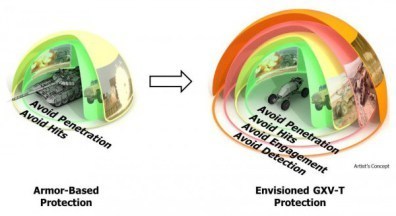 The GXV-T is intended to pursue technologies that move away from armor with the goal of making tanks 50 percent smaller, with crews half their present size, able to move at double the present speed, make them capable of operating over 95 percent of the terrain, and make them harder to detect and engage. As Kevin Massey, DARPA program manager, explained:
The GXV-T is intended to pursue technologies that move away from armor with the goal of making tanks 50 percent smaller, with crews half their present size, able to move at double the present speed, make them capable of operating over 95 percent of the terrain, and make them harder to detect and engage. As Kevin Massey, DARPA program manager, explained:
GXV-T’s goal is not just to improve or replace one particular vehicle – it’s about breaking the ‘more armor’ paradigm and revolutionizing protection for all armored fighting vehicles. Inspired by how X-plane programs have improved aircraft capabilities over the past 60 years, we plan to pursue groundbreaking fundamental research and development to help make future armored fighting vehicles significantly more mobile, effective, safe and affordable.
What this amounts to is finding ways to build tanks that can move around the battlefield like off-road vehicles, can dodge incoming fire rather than taking it, reposition its armor to its most effective angle, provide the crews with full situational awareness similar to that afforded fighter pilots, and make them stealthy against both infrared and electromagnetic detection.
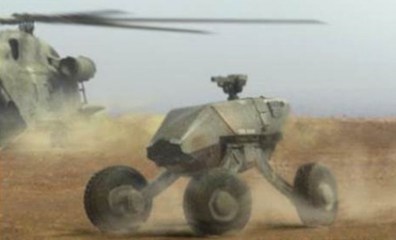 To achieve this, DARPA is soliciting new concepts and new technologies for designers. As you can see from the concept art above, some ideas have already been floated, but they remain very much in the design stage for now. The agency says that it hopes to see new GVX-T technologies emerge two years after the first contracts – which are slated to be awarded in April next year – with the hopes that the new technologies can be fast-tracked into demonstrators.
To achieve this, DARPA is soliciting new concepts and new technologies for designers. As you can see from the concept art above, some ideas have already been floated, but they remain very much in the design stage for now. The agency says that it hopes to see new GVX-T technologies emerge two years after the first contracts – which are slated to be awarded in April next year – with the hopes that the new technologies can be fast-tracked into demonstrators.
Meanwhile, General Dynamics is busy producing what will amount to the next-generation of armored vehicles. As part of a contract with the British Ministry of Defence (MoD), the company has been contracted to deliver 589 light-armor Scout Specialist Vehicles (SV) to the Army between 2017 and 2024. The tracked, medium-weight armored vehicle is designed to provide state-of-the-art, best-in-class protection for its crews.
 The Scout SV is intended to fill an important role in the British Army’s Intelligence, Surveillance, Target Acquisition and Reconnaissance (ISTAR) capability. The Scout comes in six variants based on a common platform with shared mobility, electronics, and survivability systems, has an open electronic architecture, a modular armor system, and places emphasis on the ability to upgrade in order to incorporate new technology and meet new threats.
The Scout SV is intended to fill an important role in the British Army’s Intelligence, Surveillance, Target Acquisition and Reconnaissance (ISTAR) capability. The Scout comes in six variants based on a common platform with shared mobility, electronics, and survivability systems, has an open electronic architecture, a modular armor system, and places emphasis on the ability to upgrade in order to incorporate new technology and meet new threats.
The Scout variants include Reconnaissance, Protected Mobility Reconnaissance Support (PMRS), Command and Control, Engineering Reconnaissance, Repair, and Recovery. According to General Dynamics, these are designed to provide the basics of protection, survivability, reliability, mobility and all-weather ISTAR capabilities for a wide range of extended military operations at a reduced cost.
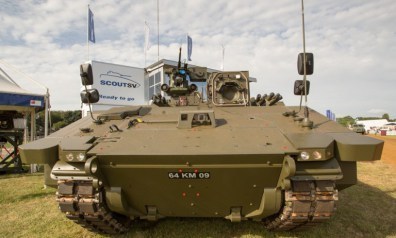 The Scout’s main armament in its turret-mounted 40-mm cannon, but it also comes equipped with acoustic detectors, a laser warning system, a local situational awareness system, an electronic countermeasure system, a route-marking system, and a high-performance power pack. The announced contract also includes the provision of support and training by General Dynamics for the delivered vehicles.
The Scout’s main armament in its turret-mounted 40-mm cannon, but it also comes equipped with acoustic detectors, a laser warning system, a local situational awareness system, an electronic countermeasure system, a route-marking system, and a high-performance power pack. The announced contract also includes the provision of support and training by General Dynamics for the delivered vehicles.
The deal represents the single biggest contract for armored vehicles that the British Army has signed since the 1980s. It also comes on the eve of a NATO Summit, and at a time when Britain is contemplating the future of its forces as it prepares for future operations similar to what it experienced in Afghanistan and Iraq. In these cases, the warfare was unconventional and prolonged, requiring a whole set of strategies.
 As British Prime Minister David Cameron declared when speaking of the deal:
As British Prime Minister David Cameron declared when speaking of the deal:
With the second largest defence budget in NATO, meeting NATO’s two per cent of GDP spending target and investing in new capabilities to deal with the emerging threats we are ensuring Britain’s national security, staying at the forefront of the global race and providing leadership within NATO.
As the saying goes: “necessity is the mother of invention”. Well, there is nothing more necessary in war than making machines that are practical, effective, and not cost the taxpayers an arm and a leg. Between dwindling budgets, improved technology, and the fact that future operations are likely to take place in war-torn and impoverished areas, the race to build a weapon-system that can handle it all is sure to be both interesting and productive!
Sources: gizmag.com, (2)


New Movie Trailer: Mockingjay Part I
 The final installment of The Hunger Games trilogy is coming soon. Or, at least the first half of it. And the first trailer has arrived. As you can see from this just-under two minute promo, the revolution that began at the end of Catching Fire is now in full swing. The games are now over, in both the literal and figurative sense, with Katniss and the President openly sparring for the future of Panem.
The final installment of The Hunger Games trilogy is coming soon. Or, at least the first half of it. And the first trailer has arrived. As you can see from this just-under two minute promo, the revolution that began at the end of Catching Fire is now in full swing. The games are now over, in both the literal and figurative sense, with Katniss and the President openly sparring for the future of Panem.
However, it is also clear that the capitol has Peeta (Josh Hutcherson) in their clutches and is using him to stop the revolution before it spreads. And true to form, Katniss wants to go and rescue him. Man, that guy is truly annoying! He’s like the male version of Bella, another superfluous character who is always in need of rescuing. And worse, the love triangle is becoming disturbingly like that Team Edward/Team Jacob crapfest!
 In any case, Julianne Moore is new to this film, playing the role of Alma Coin (leader of the resistance). Liam Hemsworth reprises his role as Gale, Woody Harrelson is back as Haymitch; and of course, Donald Sutherland is back in the austere and hauntingly-voiced role of President Snow. Part I airs this Nov. 21st, and Part 2 won’t be released until sometime in 2015.
In any case, Julianne Moore is new to this film, playing the role of Alma Coin (leader of the resistance). Liam Hemsworth reprises his role as Gale, Woody Harrelson is back as Haymitch; and of course, Donald Sutherland is back in the austere and hauntingly-voiced role of President Snow. Part I airs this Nov. 21st, and Part 2 won’t be released until sometime in 2015.
Seriously, what’s with these money-grubbing Hollywood producers and YA franchises? First Harry Potter, then Twilight, and now this!


September 15, 2014
Drone Wars: China’s Rainbow Drone Unveiled
 As part of their ongoing efforts to become a world power, China has spared no investment when it comes to the development of Unmanned Aerial Vehicle (UAV) technology. And after several successful missile tests, the People’s Liberation Army (PLA) is all set to receive the next-generation aerial drone. Known as the CH-4, the development of this UAV is just the latest in China’s attempt to catch up to western developers.
As part of their ongoing efforts to become a world power, China has spared no investment when it comes to the development of Unmanned Aerial Vehicle (UAV) technology. And after several successful missile tests, the People’s Liberation Army (PLA) is all set to receive the next-generation aerial drone. Known as the CH-4, the development of this UAV is just the latest in China’s attempt to catch up to western developers.
Although China’s drone technology may be several years behind top manufacturers in the US and Israel, the country’s UAV manufacturers are hoping that their mid-range prices and middling technology will lure potential customers from developing nations. During the unveiling, which took place at the beinnial Zhuhai Air Show in late August, officials from Kenya, Russia and other countries were on hand to witness this an other examples of China’s exportable UAVs.
 Representatives from China Aerospace Long-March International, a division of the state-owned China Aerospace Science and Technology Corporation (CASC), were on hand at the presentation and spoke with relative candor about the CH-4 and two other drones the company was showing for the first time. Guo Qian, a director at a division of CASC, when talking about the interest and marketability of the company’s military grade drones, had the following to say:
Representatives from China Aerospace Long-March International, a division of the state-owned China Aerospace Science and Technology Corporation (CASC), were on hand at the presentation and spoke with relative candor about the CH-4 and two other drones the company was showing for the first time. Guo Qian, a director at a division of CASC, when talking about the interest and marketability of the company’s military grade drones, had the following to say:
We’ve been contacting many countries, especially from Africa and Asia. They are quite interested in the intermediate and short-range UAVs because they are portable and low-cost.
Similarly, Li Pingkun , the head of the Rainbow 4 project at the aerospace corporation, told state television the drone could make a long-distance hit on a target with a margin of error of less than 1.5 metres. He said the system was very precise because it used several methods to guide missiles or smart bombs to their target. As he told ChinaNews, the drone is “well-positioned to carry out the subsequent missions.”
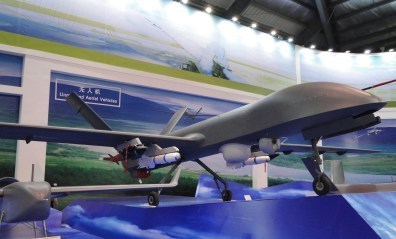 The unveiling of this drone comes at a time when the PLA is actively and publicly promoting the use of drones by its military personnel. During the show, the CASC also displayed a handful of smaller short range drones and set up a flashy ground-to-ceiling UAV attack simulation compete with a dozen technicians glued to computer screens in a the make-believe war room. As Guo explained:
The unveiling of this drone comes at a time when the PLA is actively and publicly promoting the use of drones by its military personnel. During the show, the CASC also displayed a handful of smaller short range drones and set up a flashy ground-to-ceiling UAV attack simulation compete with a dozen technicians glued to computer screens in a the make-believe war room. As Guo explained:
Our company has set up a pretty aggressive sales target for UAVs, but the global market competition is quite fierce. There are many similar products in the global market and they are quite mature, so we haven’t had a big impact in the market. It will take some time for our products to be known and accepted.
The Rainbow 4 is the CASC’s latest creation, and is intended to act as the PLA’s answer to the MQ-9 Reaper – a hunter-killer drone mainly used by the US military for reconnaissance and high-precision air strikes. The CH-4 can carry a payload of 345 kg (760 lbs) of missiles of precision-guided bombs, can reach an altitude of 8 km (26000 feet), has a range of 3,500 kilometers, and fly for up to 30 hours depending on how heavy a payload it is carrying.
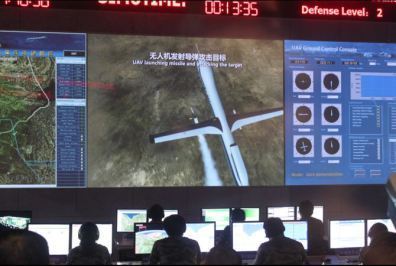 However, it remains much slower than the Reaper, which can fly at a top speed of 482 km/h compared to the Rainbow’s 235 km/h. In addition, the MQ-9 has a much higher payload of 1700 kg (3800 lbs), which works out to six Hellfire missiles or precision-guided bombs. And while it has greater range – 3000 km vs. the MQ-9’s 1850 km – the Reaper has a service ceiling of up to 18,000 meters.
However, it remains much slower than the Reaper, which can fly at a top speed of 482 km/h compared to the Rainbow’s 235 km/h. In addition, the MQ-9 has a much higher payload of 1700 kg (3800 lbs), which works out to six Hellfire missiles or precision-guided bombs. And while it has greater range – 3000 km vs. the MQ-9’s 1850 km – the Reaper has a service ceiling of up to 18,000 meters.
The PLA also has limited experience in using drones in combat zones; whereas for the USAF, drone use has become second nature. But above all, the most glaring aspect of the “drone gap” is the fact that this latest Chinese drone was not the result of indigenous design or innovation. Much like other aspects of China’s stealth and weapon’s development, it is the result of mimicry.
 Nevertheless, China’s plan to market the technology to other nations does mean that the use of UAVs is likely to become much more universal in the coming years. Beyond the US, NATO, Israel, Russia and China, middle powers like India, Pakistan, Brazil and various Sub-Saharan African nations are likely to have their own soon. In addition, certain “rogue states” – i.e. Iran, North Korea, Syria – are likely to have their own as well.
Nevertheless, China’s plan to market the technology to other nations does mean that the use of UAVs is likely to become much more universal in the coming years. Beyond the US, NATO, Israel, Russia and China, middle powers like India, Pakistan, Brazil and various Sub-Saharan African nations are likely to have their own soon. In addition, certain “rogue states” – i.e. Iran, North Korea, Syria – are likely to have their own as well.
The term “Drone Wars” is likely to become very literal as a result!
Source: gizmodo.com, scmp.com , globalpost.com





